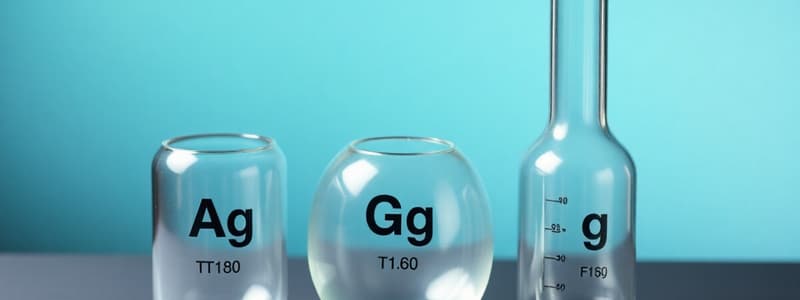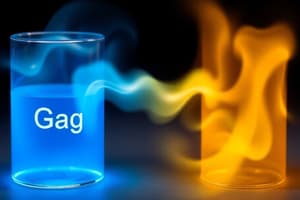Podcast
Questions and Answers
What is Dalton’s Law of Partial Pressures?
What is Dalton’s Law of Partial Pressures?
- The partial pressure of each gas increases with temperature.
- The pressure of a gas is dependent on its volume alone.
- The total pressure of a gas mixture is equal to its average temperature.
- The total pressure of a gas mixture is equal to the sum of the partial pressures of each gas within the mixture. (correct)
Which statement is accurate regarding the relationship between gas mass and speed?
Which statement is accurate regarding the relationship between gas mass and speed?
- More massive molecules move faster and have a narrower distribution.
- More massive molecules move slower and have a broader distribution. (correct)
- Molecule speed is independent of mass.
- Less massive gases always have a higher average speed.
How is the ratio of the number of molecules near certain speeds calculated?
How is the ratio of the number of molecules near certain speeds calculated?
- By multiplying the two speeds together.
- By taking the ratio of the two f values corresponding to the speeds. (correct)
- By finding the average of all molecules present.
- By adding the two speeds and dividing by two.
In a gas mixture, what does partial pressure represent?
In a gas mixture, what does partial pressure represent?
Given a total pressure of 1 atm and mole fractions of XO2=0.21, XN2=0.78, XCO2=0.01, what is the partial pressure of nitrogen (N2)?
Given a total pressure of 1 atm and mole fractions of XO2=0.21, XN2=0.78, XCO2=0.01, what is the partial pressure of nitrogen (N2)?
What happens to pressure when volume decreases for a gas at constant temperature?
What happens to pressure when volume decreases for a gas at constant temperature?
What is the graph of pressure against the inverse of volume at constant temperature shaped like?
What is the graph of pressure against the inverse of volume at constant temperature shaped like?
What is the value of the product pV for a fixed quantity of gas at constant temperature?
What is the value of the product pV for a fixed quantity of gas at constant temperature?
Which temperature is suggested to be the minimum possible temperature based on the volume-temperature law?
Which temperature is suggested to be the minimum possible temperature based on the volume-temperature law?
What must happen to pressure for the volume of gas to increase when pressure is constant?
What must happen to pressure for the volume of gas to increase when pressure is constant?
Why can experiments with real gases not be conducted at very low temperatures?
Why can experiments with real gases not be conducted at very low temperatures?
At constant pressure, how does the volume of a fixed quantity of gas relate to temperature?
At constant pressure, how does the volume of a fixed quantity of gas relate to temperature?
What describes the relationship between pressure and volume for a gas under constant temperature conditions?
What describes the relationship between pressure and volume for a gas under constant temperature conditions?
What is the primary assumption about the volume of molecules in an ideal gas?
What is the primary assumption about the volume of molecules in an ideal gas?
What does the theorem of equipartition of energy state?
What does the theorem of equipartition of energy state?
Which law relates pressure and volume of a fixed quantity of gas at constant temperature?
Which law relates pressure and volume of a fixed quantity of gas at constant temperature?
What must be true about the collisions of molecules in an ideal gas according to the model?
What must be true about the collisions of molecules in an ideal gas according to the model?
How does temperature relate to the average kinetic energy of gas molecules?
How does temperature relate to the average kinetic energy of gas molecules?
What is the relationship described by the equation of state for an ideal gas?
What is the relationship described by the equation of state for an ideal gas?
Which of the following is NOT a characteristic of molecules in an ideal gas?
Which of the following is NOT a characteristic of molecules in an ideal gas?
What happens to the volume of air in a tube as oil is pumped higher?
What happens to the volume of air in a tube as oil is pumped higher?
What does the Boltzmann Distribution Law explain about molecules in a gas?
What does the Boltzmann Distribution Law explain about molecules in a gas?
In the context of an ideal gas law problem, which quantity is essential to know to determine whether to use the number of molecules or moles?
In the context of an ideal gas law problem, which quantity is essential to know to determine whether to use the number of molecules or moles?
How should units be treated when solving an ideal gas law problem?
How should units be treated when solving an ideal gas law problem?
Which of the following is true about an isobaric process?
Which of the following is true about an isobaric process?
What does the ratio of the final to the initial states in an ideal gas law problem help achieve?
What does the ratio of the final to the initial states in an ideal gas law problem help achieve?
According to the Maxwell–Boltzmann speed distribution function, how is the number of molecules with certain speeds represented?
According to the Maxwell–Boltzmann speed distribution function, how is the number of molecules with certain speeds represented?
What defines the term 'mean' in the context of gas molecules' velocities?
What defines the term 'mean' in the context of gas molecules' velocities?
What is essential for checking the validity of the results obtained from gas calculations?
What is essential for checking the validity of the results obtained from gas calculations?
What is the formula used to calculate the partial pressure of a gas according to Dalton's Law?
What is the formula used to calculate the partial pressure of a gas according to Dalton's Law?
If the total pressure of a gas mixture is 1 atm and the mole fraction of CO₂ is 0.01, what is the partial pressure of CO₂?
If the total pressure of a gas mixture is 1 atm and the mole fraction of CO₂ is 0.01, what is the partial pressure of CO₂?
In the provided example calculations, what is the partial pressure of N₂ when its mole fraction is 0.78?
In the provided example calculations, what is the partial pressure of N₂ when its mole fraction is 0.78?
Which application of Dalton's Law is specifically important for divers?
Which application of Dalton's Law is specifically important for divers?
How does Dalton’s Law help in understanding gas behavior?
How does Dalton’s Law help in understanding gas behavior?
What is the total pressure (Ptotal) if the partial pressures are 0.21 atm for O₂, 0.78 atm for N₂, and 0.01 atm for CO₂?
What is the total pressure (Ptotal) if the partial pressures are 0.21 atm for O₂, 0.78 atm for N₂, and 0.01 atm for CO₂?
Which law provides a method for calculating total pressure in gas mixtures?
Which law provides a method for calculating total pressure in gas mixtures?
What role does the mole fraction serve in the context of Dalton's Law?
What role does the mole fraction serve in the context of Dalton's Law?
Flashcards are hidden until you start studying
Study Notes
Ideal Gas Model
- The Ideal Gas Model is based on several assumptions:
- There are a large number of molecules, and they are spread far apart.
- The molecules obey Newton's Laws of Motion and move randomly in all directions.
- The molecules interact only through short-range forces during collisions.
- Collisions with the walls are elastic.
- All gas molecules are identical.
Equation of State for an Ideal Gas
- The equation of state relates the pressure, volume, and temperature of a gas.
- Experimentally, the relationship is found to be:
- pV = nRT
- p: pressure
- V: volume
- n: number of moles
- R: universal gas constant
- T: temperature
- pV = nRT
Thermal Energy of an Ideal Gas
- The equation of state can be used to define temperature as a measure of average molecular kinetic energy.
- The equation:
- T = <KE>/ (3/2 kB)
- <KE>: average kinetic energy
- kB: Boltzmann constant
- T = <KE>/ (3/2 kB)
Theorem of Equipartition of Energy
- The theorem states that each degree of freedom of a molecule contributes (1/2) kB T to the energy of the system.
- Degrees of freedom include translational, rotational, and vibrational motions.
Pressure-Volume Law (Boyle's Law)
- At constant temperature, pressure is inversely proportional to volume:
- p₁V₁ = p₂V₂
- p ↑, V ↓
Volume-Temperature Law (Charles's Law)
- At constant pressure, volume is directly proportional to temperature:
- V₁ / T₁ = V₂ / T₂
- V ↑, T ↑
Pressure-Temperature Law (Gay-Lussac's Law)
- At constant volume, pressure is directly proportional to temperature:
- p₁ / T₁ = p₂ / T₂
- p ↑, T ↑
Boltzmann Distribution Law
- Describes the distribution of molecules with different energies.
- Probability of finding a molecule in a particular energy state is proportional to the exponential of the negative of the energy divided by kBT.
Maxwell-Boltzmann Speed Distribution Function
- Describes the distribution of molecular speeds.
- The function depends on the temperature and molecular mass.
- The distribution has a peak at the most probable speed, with a wider distribution at higher temperatures.
Dalton's Law of Partial Pressures
- States that the total pressure of a gas mixture is equal to the sum of the partial pressures of each individual gas.
- Ptotal = P₁ + P₂+ ... + Pₙ
- Partial Pressure: the pressure exerted by a single gas in a mixture.
Studying That Suits You
Use AI to generate personalized quizzes and flashcards to suit your learning preferences.




